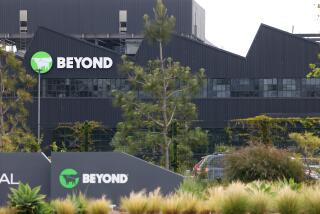India’s meatless menu diverse
- Share via
NEW DELHI — It’s not easy being a meat eater in India, the world center of vegetarianism.
With nearly 200 million strict vegetarians and an additional half a billion people who only rarely sample meat, India caters to vegetarians as the norm. Most supermarkets are vegetarian. So are many roadside restaurants, their signs touting “Veg,” “Pure Veg” or “100 Percent Vegetarian” cuisine. In India, it is meat eaters, not vegetarians, who must comb the menu to find something appealing.
I am not a particularly devoted carnivore. I have at times gone months without eating meat, largely because I was too lazy to make anything for dinner beyond a bowl of cereal. I also have spent much of my adult life working in meat-loving regions of the world where being a vegetarian amounts to eating plates of rice and French fries and little else.
But now I have carnivorous children, raised in South Africa, where a unifying cultural feature across all races and ethnicities is a love of grilled sausage and chops. For them, India is a culinary puzzle.
At the local McDonald’s, for instance, there is no beef. India’s Hindu majority reveres the cow as a holy mother, so slaughter of cattle is banned. Bacon is out as well because of India’s significant Muslim minority. That leaves fish and chicken sandwiches, served with egg-free mayonnaise. But the biggest selection at McDonald’s is vegetarian: a McVeggie burger with its pea, carrot and potato patty; the McAloo Tikki, a cousin of hash browns served up on a bun; and the Veg McCurry Pan, a mix of veggies in bread and egg-free bechamel sauce.
My small cheeseburger lovers, free balloons drooping in disappointed hands, opt to eat just the French fries.
India’s vegetarian sensibilities date back to about 500 BC, when growing Buddhism and Jainism -- an offshoot of Hinduism that abhors any taking of life -- began pushing the country’s meat-eating early pastoralists off the cultural map.
Today, many Indian Hindus eschew meat-eating as a drag on spiritual advancement, a potential karmic burden and simply cruel. Some Jains, the strictest of vegetarians, won’t touch even carrots or onions for fear that insects or worms were harmed as the vegetables were pulled from the ground.
“Meat-eating contributes to a mentality of violence, for with the chemically complex meat ingested one absorbs the slaughtered creature’s fear, pain and terror,” warns Satguru Sivaya Subramuniyaswami, a revered Hindu guru.
Other Indians, in a nation still mired in widespread poverty, simply cannot afford chicken, goat or mutton, the main meat options here. Some Indians adopt a vegetarian diet for health reasons.
Thankfully, Indian vegetarianism, although banning eggs, embraces dairy products, including staples such as yogurt, cottage cheese and -- in our family, at least -- McDonald’s milkshakes. And for the enterprising Delhi carnivore, bored with ground mutton meatloaf, a little anxious about eating fish in a hot city far from the sea and not exactly thrilled about a chicken-heavy diet in the land of bird flu, there are other options as well.
If you know the right telephone number, I’m told, a Muslim butcher will come with a side of beef and chop it to your taste. In certain refrigerated cabinets of certain discerning up-market retailers, you can also find American-style bacon for $15 a pound.
Best of all, if you look at the very bottom of the Pizza Hut delivery menu, beneath the Simply Veg, Veggie Crunch, Spicy Veggie, Veggie Taka Tak, Veggie Lovers and Veggie Supreme offerings, there’s a minor miracle: Pepperoni pizza.
Still, in the land of fragrant cauliflower curry, spicy fried lentil soup and tantalizing warm carrot pudding, the best option is slowly becoming clear. We need to bite the bhajia -- a veggie fritter -- and join the crowd.
More to Read
Eat your way across L.A.
Get our weekly Tasting Notes newsletter for reviews, news and more.
You may occasionally receive promotional content from the Los Angeles Times.










